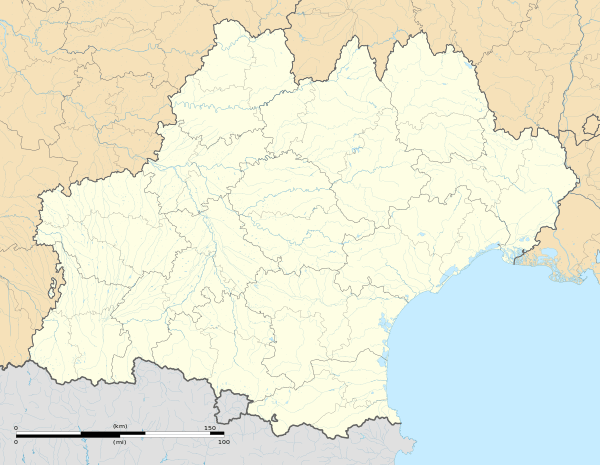Artigues, Ariège
Artigues is a commune in the Ariège department in the Occitanie region of south-western France.
Artigues | |
|---|---|
A street in Artigues | |
Location of Artigues 
| |
 Artigues  Artigues | |
| Coordinates: 42°43′07″N 2°04′11″E | |
| Country | France |
| Region | Occitanie |
| Department | Ariège |
| Arrondissement | Foix |
| Canton | Haute-Ariège |
| Intercommunality | CC Haute-Ariège |
| Government | |
| • Mayor (2014-2020) | Jean-Luc Annouilles |
| Area 1 | 12.43 km2 (4.80 sq mi) |
| Population (2017-01-01)[1] | 56 |
| • Density | 4.5/km2 (12/sq mi) |
| Time zone | UTC+01:00 (CET) |
| • Summer (DST) | UTC+02:00 (CEST) |
| INSEE/Postal code | 09020 /09460 |
| Elevation | 990–2,547 m (3,248–8,356 ft) (avg. 1,100 m or 3,600 ft) |
| 1 French Land Register data, which excludes lakes, ponds, glaciers > 1 km2 (0.386 sq mi or 247 acres) and river estuaries. | |
The inhabitants of the commune are known as Artiguois or Artiguoises.[2]
Geography
Artigues is a remote mountain commune some 25 km south by south-west of Quillan and 20 km east of Ax-les-Thermes in a direct line. The D16 road from Rouze to Le Pla passes through the north-eastern corner of the commune but has no access to the commune. Access to the village is by a small mountain road, Laoutre, from Mijanès in the north-west. The commune is extremely rugged and heavily forested with alpine vegetation below the snow line. There is some farming activity near the village.[3]
The Ruisseau de Boutadieu forms the south-eastern border of the commune and flows north to join the Ruisseau d'Artigues which forms the rest of the eastern border as it flows north to join the Quérigut River just north of the commune. The Ruisseau de Laurenti rises in the south of the commune and flows north into the Étang de Laurenti in the south-centre of the commune. From there it continues east to join the Ruisseau de Boutadieu. The Ruisseau de Fournet rises in the centre of the commune and flows north to join the Bruyante west of the commune. The Barrage de Noubais is on the northern border of the commune and the stream flowing out of it forms the northern border as it flows north-east to join the Quérigut.[3]
Neighbouring communes and villages[3]
Administration
List of Successive Mayors[4]
| From | To | Name | Party | Position |
|---|---|---|---|---|
| 2001 | 2008 | Édouard Macou | ||
| 2008 | 2020 | Jean-Luc Annouilles |
(Not all data is known)
Demography
In 2010 the commune had 50 inhabitants. The evolution of the number of inhabitants is known from the population censuses conducted in the commune since 1793. From the 21st century, a census of communes with fewer than 10,000 inhabitants is held every five years, unlike larger towns that have a sample survey every year.[Note 1]
| 1793 | 1800 | 1806 | 1821 | 1831 | 1836 | 1841 | 1846 | 1851 |
|---|---|---|---|---|---|---|---|---|
| 234 | 127 | 277 | 287 | 307 | 313 | 337 | 319 | 352 |
| 1856 | 1861 | 1866 | 1872 | 1876 | 1881 | 1886 | 1891 | 1896 |
|---|---|---|---|---|---|---|---|---|
| 320 | 350 | 351 | 376 | 358 | 322 | 324 | 306 | 260 |
| 1901 | 1906 | 1911 | 1921 | 1926 | 1931 | 1936 | 1946 | 1954 |
|---|---|---|---|---|---|---|---|---|
| 218 | 208 | 184 | 159 | 139 | 125 | 105 | 102 | 101 |
| 1962 | 1968 | 1975 | 1982 | 1990 | 1999 | 2006 | 2010 | - |
|---|---|---|---|---|---|---|---|---|
| 67 | 60 | 50 | 29 | 21 | 38 | 63 | 50 | - |

Sites and monuments
In the Parish Church are several objects which are registered as historical objects:
- 2 Statues: Saint Just and Saint Pasteur (18th century)

- A Chalice (17th century)

- 6 Candlesticks (17th century)

- A Chandelier (18th century)

See also
External links
- Artigues on the National Geographic Institute website (in French)
- Artigues on Lion1906
- Artigues on Géoportail, National Geographic Institute (IGN) website (in French)
- Arugues on the 1750 Cassini Map
Notes and references
Notes
- At the beginning of the 21st century, the methods of identification have been modified by Law No. 2002-276 of 27 February 2002 Archived 6 March 2016 at the Wayback Machine, the so-called "law of local democracy" and in particular Title V "census operations" allows, after a transitional period running from 2004 to 2008, the annual publication of the legal population of the different French administrative districts. For communes with a population greater than 10,000 inhabitants, a sample survey is conducted annually, the entire territory of these communes is taken into account at the end of the period of five years. The first "legal population" after 1999 under this new law came into force on 1 January 2009 and was based on the census of 2006.
References
- "Populations légales 2017". INSEE. Retrieved 6 January 2020.
- Inhabitants of Ariège (in French)
- Google Maps
- List of Mayors of France (in French)
- Ministry of Culture, Palissy PM09000026 2 Statues: Saint Just and Saint Pasteur (in French)
- Ministry of Culture, Palissy PM09000025 Chalice (in French)

- Ministry of Culture, Palissy PM09000024 6 Candlesticks (in French)

- Ministry of Culture, Palissy PM09000023 Chandelier (in French)

| Wikimedia Commons has media related to Artigues (Ariège). |